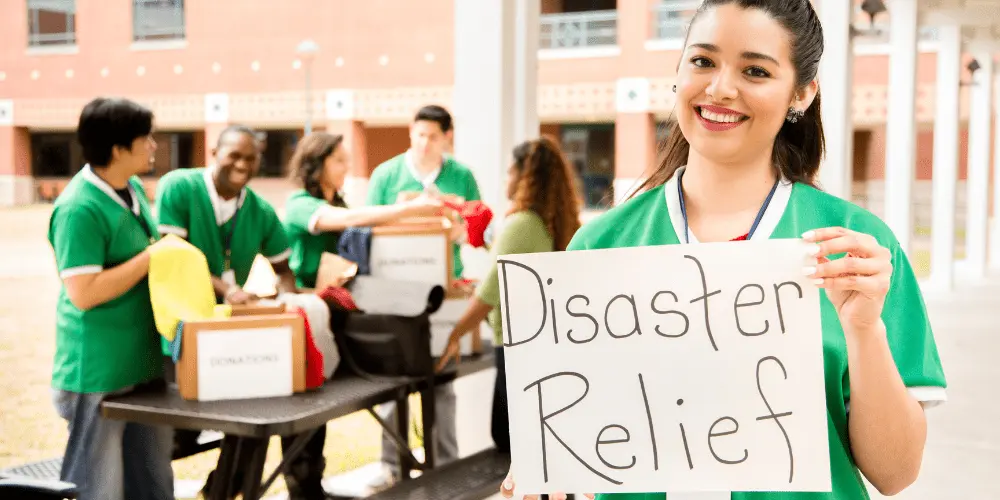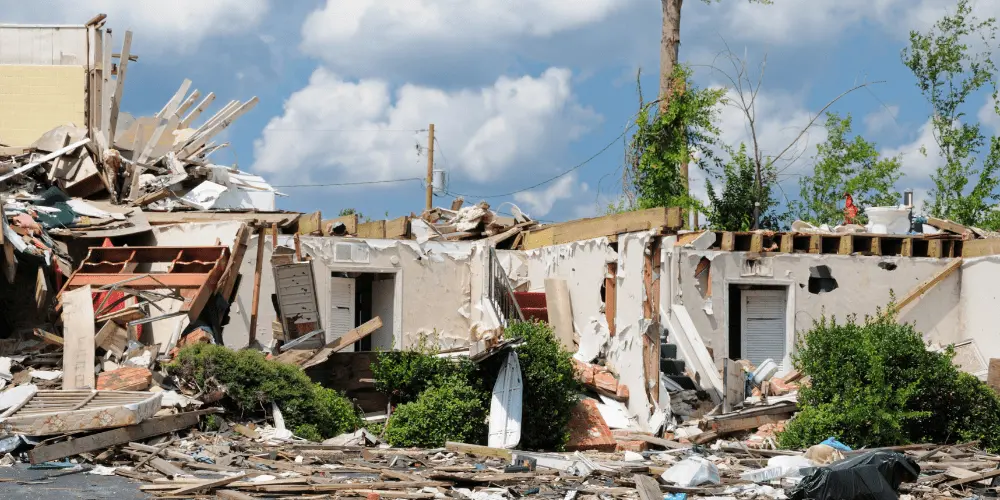
It’s normal to feel overwhelmed when a disaster strikes. Families may be displaced, lose income, or face sudden medical expenses. The first step is always safety: make sure everyone is secure, then document damages with photos and notes. Disasters can happen anywhere on the world globe, and FEMA responds across the country when local resources are stretched thin. When the U.S. flag is lowered to half-staff after a storm or fire, it often symbolizes the national scale of loss and the beginning of federal aid.
FEMA disaster assistance is financial and housing support provided by the Federal Emergency Management Agency after a federally declared disaster. This aid helps survivors cover temporary housing, medical bills, or replacing food that spoiled in a power outage.
For example, one household used FEMA aid to cover rent while repairing their damaged home. If you’re new to disaster planning, Credit.org’s guide on Top Disaster Recovery Solutions for Homeowners offers helpful background.
FEMA aid becomes available only after a major disaster is declared by the President. This decision depends on the scale of the event, the damage reported by state leaders, and the need for federal support. Across the country, communities rely on FEMA to step in when recovery is beyond local capacity.
The federal government directs FEMA through the Department of Homeland Security. This structure ensures that disaster relief is consistent across states and that emergency management remains a national priority. Coordination with state offices and local agencies is critical for making aid available quickly.
FEMA’s programs are designed to help disaster survivors rebuild their lives. You can apply as an individual, jointly with a spouse, or as part of a household. Assistance may cover housing, child care, car repairs, or funeral costs. In some cases, deadlines are extended into July (a frequent FEMA grant deadline) to ensure survivors have enough time. If you’re unsure where to begin, see Credit.org’s article Who Qualifies for FEMA Relief? Eligibility Requirements Explained.
The Individuals and Households Program is FEMA’s main source of direct support. It may cover rental housing, home repair, or child care. Families who prepare ahead with documents and receipts often move faster through the system. You can check the status of an application online or by phone, and once approved, funds are distributed quickly.
Other Needs Assistance goes beyond housing. It can cover funeral expenses, personal property, or the replacement of appliances and medical devices. ONA may also help with car repairs if the vehicle was damaged during the disaster. This flexible program is vital for meeting everyday needs when money is tight.
Private nonprofit organizations also step in to provide food, clothing, and cleanup supplies. Their efforts, supported by local and tribal governments, complement FEMA’s role. Community development programs may also fund long-term rebuilding, especially for low-income neighborhoods.
FEMA is not a substitute for insurance. Survivors must first file a claim with their insurance company. Quick repairs not only protect your insurance claim, they also restore your family’s safety at home. Grants may help cover costs left unpaid by insurance, making sure households are not left without shelter.

Emergency management is a partnership of federal, state, tribal, and local agencies. FEMA’s efforts are supported by businesses, nonprofits, and communities working together. Programs may include flood repair, property cleanup, or new housing development for affected neighborhoods.
If you are affected by a disaster, you may need additional information on eligibility, deadlines, or appeals. Contact FEMA directly with questions. On FEMA’s site, click the search icon to find resources by state or program. Always use official "dot gov" websites to avoid scams and protect your personal information. For counseling and planning support, Credit.org’s forthcoming article How to Access Disaster Recovery Services in Your Community will explain how to find help locally.
FEMA assistance is distributed through direct payments, grants, or reimbursements to households and businesses. The process may involve sending paperwork, notices of approval, or deadlines for submitting forms. This structure allows FEMA to provide assistance quickly while protecting against fraud.
FEMA partners with state agencies, local offices, and tribal governments to support households and communities. Homeowners may get grants for repairs, businesses can apply for reopening funds, and families may receive funeral reimbursements. These programs show how aid extends beyond one person to strengthen entire communities.
Disaster survivors often face basic challenges like feeding their families. FEMA may provide assistance for replacing food lost during outages or floods. ONA can also help with funeral expenses, car repairs, and medical devices. These programs ensure no one is left without essentials.
FEMA also helps with funeral expenses when lives are lost in disasters. If deadlines are extended, survivors are notified by letter or through FEMA’s website. This ensures all affected families have the chance to apply for critical support.
Applications are reviewed carefully, and once approved, survivors gain access to FEMA services such as rental aid, repair grants, and counseling referrals. Across the country, billions have been distributed to help rebuild communities. Having quick access to these programs is essential for helping families recover. For smoother filing, Credit.org’s forthcoming article FEMA Disaster Assistance Application: Tips for a Smooth Process will walk you through common steps.
To apply, call 1-800-621-3362 (TTY 1-800-462-7585), visit DisasterAssistance.gov, or use the FEMA mobile app. On the website, look for the search icon to find the right section. Be ready with your address, insurance details, and damage description. You can also check the status of your application online or by calling the FEMA helpline.
Disaster survivors may feel alone, but FEMA assistance exists to provide support. Whether you are replacing food, repairing a home, or applying for funeral aid, there are resources to help you recover. Start with an application, check your status, and reach out for guidance when needed.
If you need more support, Credit.org’s disaster recovery counseling can help you create a plan, review your finances, and take steady steps forward. No matter how overwhelming it feels today, recovery is possible.